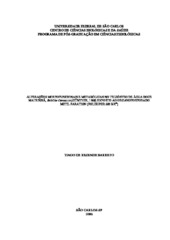Alterações morfofuncionais e metabólicas no teleósteo de água doce matrinxã, Brycon cephalus (Günther, 1869) exposto ao organofosforado metil paration (Folisuper 600BR®)
Abstract
The xenobiotics influxes into the aquatic systems are continuous increasing in Brazil
due to their use in the agriculture and to control insects in aquaculture. In the present
study was evaluated if the exposure of the freshwater teleost fish matrinxã (Brycon
cephalus) to sublethal concentration of the organophosphorus pesticides
methylparathion (MP) induce morphofunctional changes in the interrenal cells and in
the gills as well as metabolic changes in this species. Specimens of matrinxã were
divided in two groups with 7 animals in each one and kept in aquarium with 200L. One
of them was the control group and was kept in water without the presence of MP and
the other was the MP group and was exposed to 2 ppm of methyl parathion during 96
hours. Food was suspended for both groups 24 hours before the transference of fish to
their respective aquarium and fish were maintained 12 hours in the aquarium for
acclimatizing before experiments. Fish exposed to MP reduced the swimming activity
and histological changes were observed in the interrenal cells as increasing of cell and
nucleus areas and also the ration nucleus area/cellular area indicating an increase of cell
activity, which cortisol is the major corticoid produced by these cells. Plasma cortisol
also increased in fish exposed to MP. The histological changes in the gills were
classified as slight to moderate. The hematological analysis support it hypothesis as no
change was found in the blood hematology and in their indexes. Glucose concentration
in plasma increased in fish exposed to MP while it decreased in the liver. Lactate
concentration decreased in plasma and liver of animals exposed to MP suggesting an
absence of internal hypoxia and supports the indication that the gill function was
partially maintained. Piruvate concentration did not change, but the ammonia levels
increased in plasma and liver in fish exposed to 96h to MP. These results suggest that
gluconeogenesis occurred and the high level of glucose was kept high to maintain the
energy supply to tissues. In conclusion, the results evidenced that the exposure to 2 ppm
of methyl parathion caused an increase of area of interrenal cells suggesting the
activation of Hypothalamic-Pituitary-Interrenal axis e slight to moderate changes in the
gill tissues although they partially kept their function. The changes in liver metabolism
are probably related to the increase of energy demand of fish.
